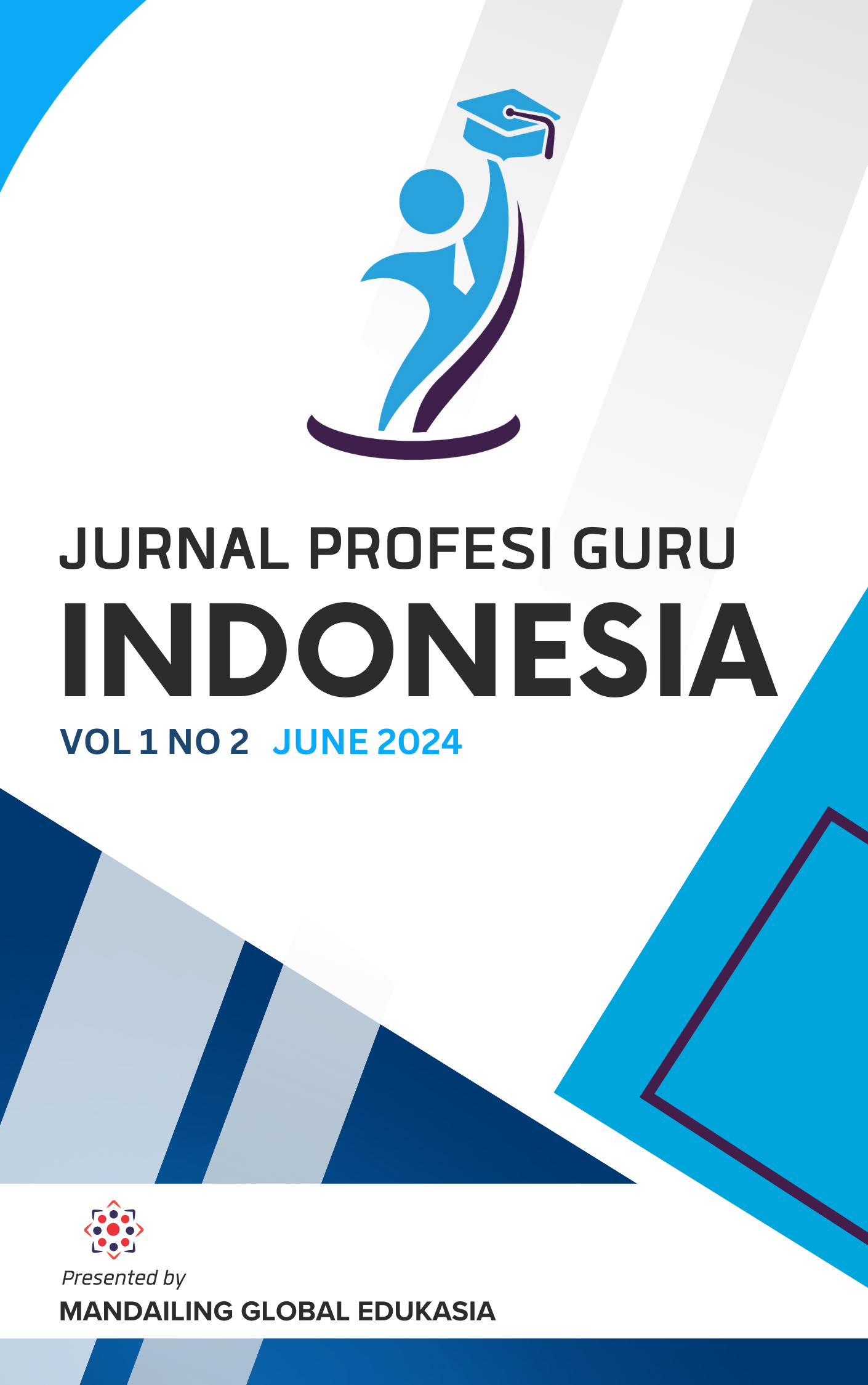The Role of Islamic Religious Education Teachers in Instilling Character Values in Students at Atong State Elementary School
DOI:
https://doi.org/10.62945/jpgi.v1i2.691Keywords:
character, learning outcomes, Islamic religious educationAbstract
Islamic Religious Education teachers have a large role in instilling character values in their students, teachers have a strategic position as the main actor. The attitude and behavior of a teacher leaves a deep impression on the student, so that the character and personality of the teacher becomes a mirror of the student. teachers have a great responsibility in producing a generation with character, culture and morals. There are still many students who have not been able to apply character values in the school environment or at home. Therefore, the writer is interested in choosing a title about the role of Islamic Religious Education teachers in instilling the character values of class V students in SD Negeri Atong. This research aims to find out the role of Islamic Religious Education teachers in instilling character values in students to find out the methods, supporting factors and obstacles faced in instilling character values in Atong State Elementary School, especially class V. This type of research is Field Research, which is research that requires the researcher to go to the 'field' to observe a phenomenon in a natural state. The data sources used are primary data sources and secondary data sources. Data collection methods are interviews, observations and documentation. While the data analyst technique used is inductive through data reduction, data presentation (data display) and conclusion (verification). The conclusion obtained is that the role of Islamic Religious Education teachers in instilling character values in students can be through group activities with the hope of applying the character of discipline and responsibility. In addition to the application of 7s (smile, greeting, hello, polite, polite, patient and grateful). The methods used in instilling character values can be through exemplary methods, advice methods, demonstration methods, and discussion methods. A supporting factor in instilling character values is the existence of facilities and infrastructure that support and media telling stories. whereas the inhibiting factors in instilling character values include the busyness of parents, the environment, and the mass media. Further, the solution to overcome obstacles in instilling character values is the assignment of tasks and cooperation between teachers and parents.
Downloads
References
Arikunto, S. (2002). Prosedur Penelitian. Bandung: Rineka Cipta.
Apriyanti, I., & Rahayu, S. (2024). Efforts to Improve Student Learning Outcomes through the Problem Based Learning Model in Islamic Education Learning at SD Negeri 104325 Kampung Manggis. Journal of Indonesian Primary School, 1(2), 61–68.
Elistiana, V., Novita, N., & Ginting, F. W. (2024). A Development of E-Module Learning Media based on SETS (Science, Environment, Technology, and Society) on Sound Wave Material. Indonesian Journal of Education and Social Humanities, 1(2), 20–32.
Erawadi, E., Hamka, H., & Juliana, F. (2017). The Analysis of Student’s Stressed Syllables Mastery at Sixth Semester of TBI in IAIN Padangsidimpuan. English Education: English Journal for Teaching and Learning, 5(1), 44–57.
Hamka, H. (2023). The Role of Principals on Teacher Performance Improvement in a Suburban School. QALAMUNA: Jurnal Pendidikan, Sosial, Dan Agama, 15(1), 371–380.
Hamka, H., Suen, M.-W., Anganthi, N. R. N., Haq, A. H. B., & Prasetyo, B. (2023). The Effectiveness of Gratitude Intervention in Reducing Negative Emotions in Sexual Abuse Victims. Psikohumaniora: Jurnal Penelitian Psikologi, 8(2), 227–240.
Harahap, D. S. (2024). Implementation of ChatGPT to Improve Students’ Critical Thinking Abilities. Indonesian Journal of Education and Social Humanities, 1(2), 33–39.
Harahap, S. M., & Hamka, H. (2023). Investigating the Roles of Philosophy, Culture, Language and Islam in Angkola’s Local Wisdom of ‘Dalihan Na Tolu.’ HTS Teologiese Studies/Theological Studies, 79(1), 8164.
Indrawati, N., & Desky, A. Y. D. (2024). How to Improve Elementary School Student Learning Outcomes by Implementing the Articulation Type Cooperative Learning Model? Journal of Indonesian Primary School, 1(2), 32–37.
Jannah, A., Lubis, A. H., & Julia, N. M. (2024). Development of Number Card Media in Mathematics Learning for Elementary School Students. Journal of Indonesian Primary School, 1(3), 12–23.
Latifah, I., & Safrida, I. (2025). Improving Students’ Language Skills with Punakawan Wayang Media at RA Mansyaul Huda: A Classroom Action Research. Journal of Indonesian Primary School, 2(1), 13–24.
Lubis, A. H. (2024). Improving Elementary School Students’ Reading Skills Using Picture Word Cards: How is This Possible? Journal of Indonesian Primary School, 1(2), 9–18.
Lubis, A. H., & Lubis, S. S. W. (2024). Development of Newsletter Media in Thematic Learning for Elementary School Students. Indonesian Journal of Education and Social Humanities, 1(1), 28–36.
Mauliana, I., Ulfa, N., & Fitria, A. (2024). Improving Student Learning Outcomes with the Problem Based Learning Model: Classroom Action Research at the State Islamic Primary School. Indonesian Journal of Education and Social Humanities, 1(2), 1–8.
Misqa, L., Oviana, W., Hayati, Z., & Jannah, M. (2024). Improving Student Learning Outcomes in Mathematics Learning through a Contextual Teaching and Learning Approach in Elementary Schools. Journal of Indonesian Primary School, 1(2), 19–26.
Muliawati, I., & Aldin, A. (2024). The Effectiveness of the Problem Based Learning Model on Elementary School Students’ Mathematics Learning Outcomes. Journal of Indonesian Primary School, 1(2), 27–31.
Nurliza, M., Lubis, A. H., & Lubis, S. S. W. (2024). Word Square Model Used by Poster Media to Improve Primary School Student Learning Outcomes. Journal of Indonesian Primary School, 1(1), 19–28.
Rahayu, L., & Daud, R. M. (2024). SAS Method assisted by Picture Story Books to Improve Elementary School Students’ Beginning Reading Ability. Journal of Indonesian Primary School, 1(1), 37–46.
Rahmah, S., & Lubis, A. H. (2024). Problem Posing as a Learning Model to Improve Primary School Students’ Mathematics Learning Outcomes in Gayo Lues. Journal of Indonesian Primary School, 1(4), 93–104.
Simamora, R. (2024). A Survey Research: What is the Role of the Mendeley Application in the Student Environment? Indonesian Journal of Education and Social Humanities, 1(2), 40–45.
Sugiyono. (2018). Metode Penelitian Kuantitatif Kualitatif dan R&D. Bandung: Alfabeta.
Downloads
Published
How to Cite
Issue
Section
License

This work is licensed under a Creative Commons Attribution-ShareAlike 4.0 International License.









